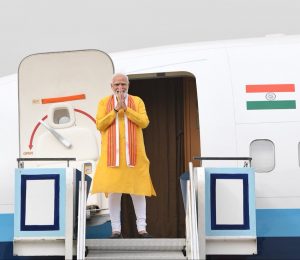
Buddha’s blessings permeated the air as Prime Minister Narendra Modi touched down in Lumbini, the birthplace of Lord Buddha, for a four-hour visit, his first trip to Nepal after his 2019 re-election which will pivot around culture and connectivity.

PM Modi could not have chosen a more auspicious day to celebrate the shared civilisational heritage and fraternal ties between the people of India and Nepal. PM Modi’s brief visit to Lumbini on Buddha Purnima day on May 16 will highlight deeper spiritual connections that bind India and Nepal, rather than merely transactional calculations that characterise the approach of some countries.
PM’s visit to Lumbini is “a celebration of the time-honoured civilizational and people to people linkages between India and Nepal, which forms a very strong foundation of our close and multifaceted relationship,” said India’s Foreign Secretary Vinay Mohan Kwatra, setting the tone for the visit. “Mutual visits to places of shared cultural and civilizational heritage, further reinforce these linkages,” he said.
Although very brief, PM Modi’s will pack in many engagements, including a “darshan” at the iconic Mayadevi Temple, which lies at the very heart of Lumbini and marks the site of the birth of Lord Buddha. During his visit to Nepal in in November 2014, PM Modi had gifted Bodhi tree sapling from Bodhgaya to this temple. Mr Modi will visit the monastic zone in Lumbini, where he will participate in the Shilanyas ceremony for the construction of a center for Buddhist culture and heritage, built by the India-based International Buddhist Confederation.
Energising Ties
Besides cultural diplomacy, there will also be talks between PM Modi and his Nepali counterpart Sher Bahadur Deuba for advancing bilateral cooperation in areas such as hydropower development, connectivity and education.

The two leaders will pick up the conversation from where they left during Mr Deuba’s visit to Nepal and are expected to focus on bolstering connectivity through road and air as Kathmandu pushes for more air entry corridors to India. The two sides are also expected to move forward with a proposal for establishing a satellite campus of a prestigious Indian university in Kathmandu.
A holistic approach to hydropower development under which India will not only invest and build hydro-electric power units in Nepal but also build the transmission lines to evacuate power for sale across the border will be an important outcome of PM’s visit.
China’s shadow will loom large as the Nepali leader will come to meet PM Modi in Lumbini only after inaugurating a Chinese-upgraded airport in Bhairahawa, thereby underlining a power play between the two Asian giants for influence in the Himalayan state. Modi’s visit to Lumbini will send a message to China that India-Nepal ties are spiritually moored and its people-to-people bridge is stronger than shiny infrastructure.
Author Profile

- Manish Chand is Founder and Editor-in-Chief of India Writes Network (www.indiawrites.org) and India and World, a pioneering magazine focused on international affairs. He is CEO, Centre for Global India Insights, an India-based think tank focused on global affairs.
Latest entries
 India and the WorldOctober 27, 2025Modi hails the century of India and ASEAN, backs ASEAN centrality
India and the WorldOctober 27, 2025Modi hails the century of India and ASEAN, backs ASEAN centrality India and the WorldOctober 26, 2025Act East: Five reasons why ASEAN summit in Malaysia matters
India and the WorldOctober 26, 2025Act East: Five reasons why ASEAN summit in Malaysia matters India and the WorldOctober 25, 2025Malaysia Summit: India can play a bigger role in ASEAN: Anil Wadhwa
India and the WorldOctober 25, 2025Malaysia Summit: India can play a bigger role in ASEAN: Anil Wadhwa India and the WorldOctober 2, 2025With US frowning, India to host Putin in December
India and the WorldOctober 2, 2025With US frowning, India to host Putin in December







